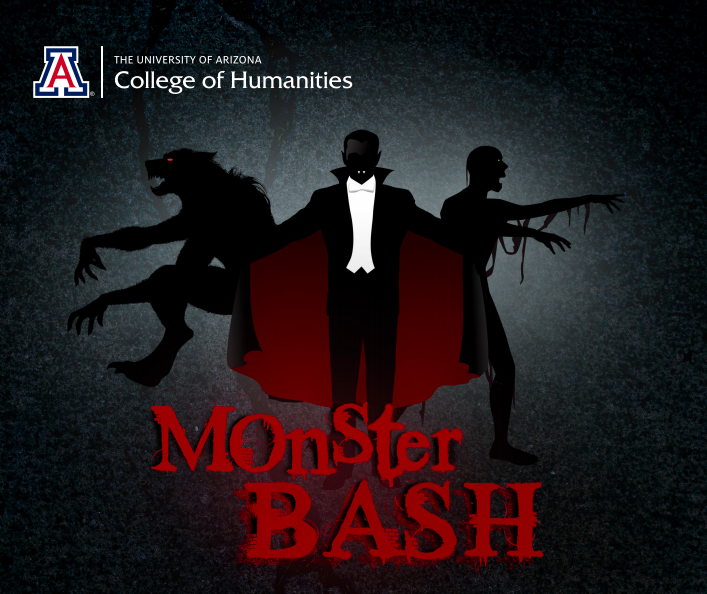Vampires, werewolves and zombies will be the talk of the University of Arizona Mall on Thursday, April 11, as the College of Humanities hosts its Monster Bash.
Vampires and Werewolves and Animation to Zombies are two courses offered by the college that dive deep into the topics of werewolves, vampires and zombies all the way from early Slavic folklore to Western depictions of these creatures in modern-day films.
The Monster Bash will be showcasing the two courses and will feature interactive student projects, according to Colleen Lucey, an assistant professor in the Russian and Slavic studies department. The event is free, open to the public and will include games, trivia, food and costumes.
RELATED: Relay for Life brings community together to run against cancer
Beneath the suspense and gore of these figures, these courses pose some very poignant questions, Lucey said. What does it mean to be human?; What is life?; and What is death? are all questions the Monster Bash will celebrate. The bash looks to get more students involved in the course and the study of these topics.
“Vampires and werewolves reflect very real fears & anxieties in our society,” Lucey said. “The image of the werewolf/vampire has continued to evolve but still represent fears that are still alive in our society today.”
Those fears can include racial differences, anxieties over death/disease and clashes between social classes, Lucey explained.
“Vampires are sometimes said to symbolize the upper class, sucking the life out of the working class,” Lucey said. “Vampires also dealt with mankind’s fears surrounding death.”
When disease and contagion were not well understood, vampires came to embody mankind’s fears over catching disease and becoming infected, Lucey said. It also reflected the fear over leaving loved ones behind.
In early Slavic depictions of vampires, they would come back from the dead to bring their loved ones with them into the afterlife, Lucey said.
“Werewolves deal with another human anxiety. They give expressive power over periods of transition, such as puberty,” Lucey said, adding there are key differences between how female werewolves are depicted when compared to male werewolves.
At the root of it, these courses also examine how society has chosen to include some while simultaneously excluding others.
“This course deals with those concerns over inclusivity, diversity and fear of anyone who may be different. Werewolves and vampires still represent our modern-day fears of outsiders and matters of life and death,” Lucey said.
Lucey’s course examines film/literature depictions of these creatures and uses those methods as a springboard for a class discussion. Lucey’s students get to sample everything from early Slavic folklore to Nosferatu, the original vampire depiction in film, to Bram Stoker’s “Dracula“ and even “Twilight.”
RELATED: Ph.D. student strings together modern American guitar history
“Twilight” is studied because of its rare depiction of vampires as “non-threatening” and its heteronormative approach to the creature. “These figures really tell us a lot about ourselves,” Lucey said.
Joela Jacobs, an assistant professor of German studies teaching the Animation to Zombies course, explained how studying depictions of zombies in media also begs the question “What is life?” and deals with survival and immortality through an interdisciplinary perspective.
Zombies go back to Haitian folklore and symbolize slavery, Jacobs said. They are prevalent in American culture because the U.S. occupied Haiti and brought back a lot of the voodoo stories.
A zombie has come to symbolize in today’s economy a kind of mindless worker. It still has a lot to do with slavery, but a slavery of the mind, Jacobs explained.
“That is what it has come to mean in American culture,” Jacobs said.
Jacobs said students have responded with interest and intrigue to these classes.
“We encourage a lot of critical thinking, and students are enjoying that,” Jacobs said. Jacobs’ course currently has a waiting list and is usually full. She caps her class size at 250 students.
Jacob McQuaid is a nutritional sciences major currently taking Jacobs’ zombie-themed course. McQuaid said he became intrigued in the class after reading a description of it online.
“We recently studied and discussed in class what different types of zombie movies can represent metaphorically,” McQuaid said. “They can be used in so many different ways as a commentary or point of view regarding social issues that we deal with overtly, or controversial ideas that are more philosophical that come along with being human.”
McQuaid said he enjoys getting to study various depictions of these fictional figures in media.
“My favorite fictional character is the old faun from “Pan’s Labyrinth.” He serves as a guide to the main character, Ofelia,” McQuaid said. “Everyone could use a shepherd to focus them through life’s struggles and distractions in order to better themselves for a greater purpose.”
Overall, McQuaid said he has enjoyed the course and highly recommends it to other UA students.
“This class is great for challenging how you think and understand the world as it is. It’s opened my eyes to philosophical point of views I had never really considered,” McQuaid said.
The Monster Bash will take place April 11 on the UA Mall. To find out more about courses or events, visit the Department of Russian & Slavic Studies website.
Follow Nicole on Twitter









